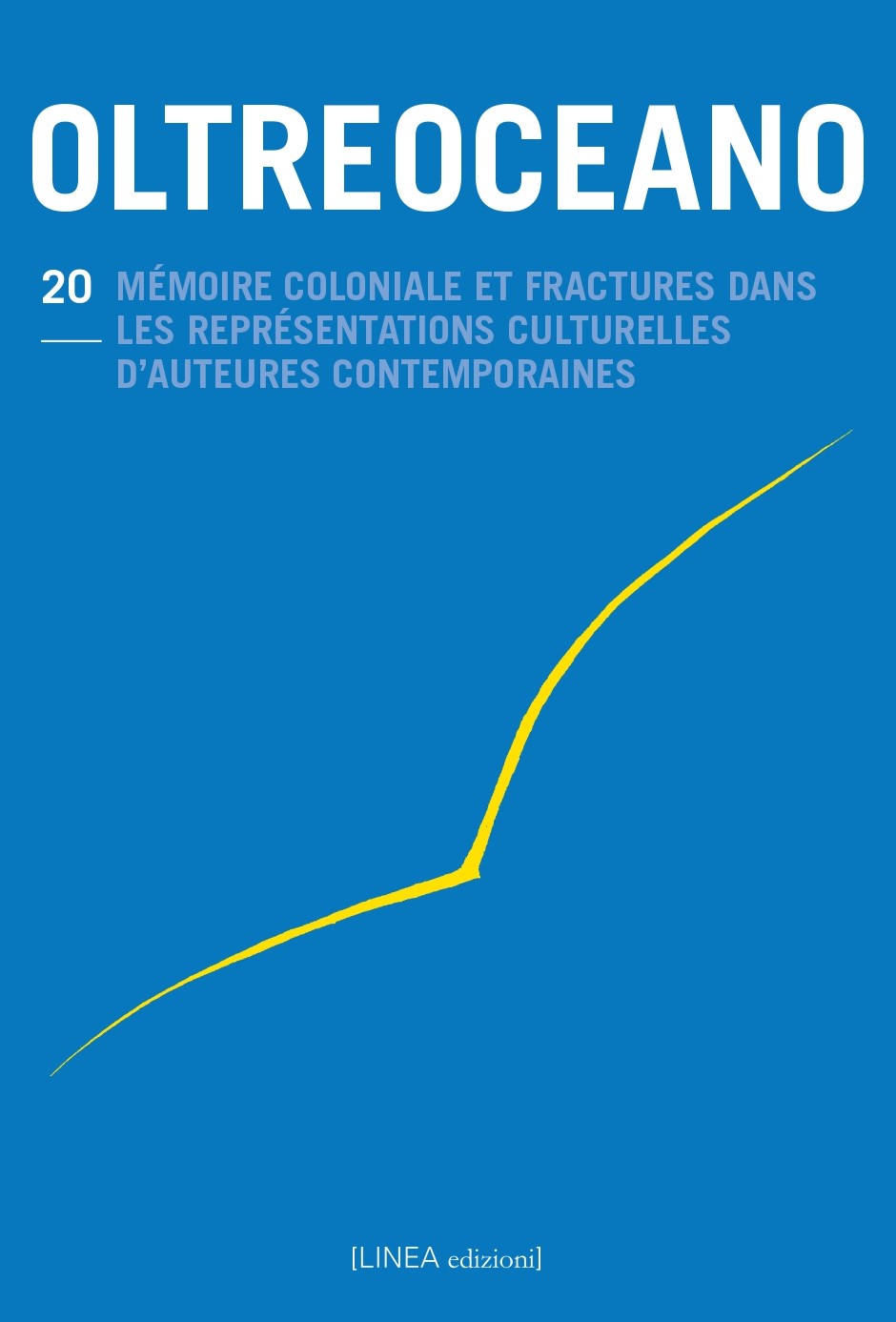Un pas de chat sauvage de Marie NDiaye: histoire d’un regard
DOI:
https://doi.org/10.53154/Oltreoceano48Keywords:
regard, identité modèle/copie, postcolonialeAbstract
Publié dans le cadre de l’exposition Le modèle noir de Géricault à Matisse, organisée au musée d’Orsay en 2019, Un pas de chat sauvage de Marie NDiaye interroge l’imaginaire colonisant du corps féminin par le biais de la femme noire Marie l’Antillaise, photographiée par Nadar en 1850. Je me propose de démontrer que le véritable enjeu de ce court récit est la question d’une identité qui passe à travers le regard: le regard des autres, le regard sur soi-même de la part d’une autrice qui s’est toujours considérée comme étrangère à la question coloniale, enfin le regard de la littérature.
Un pas de chat sauvage by Marie NDiaye: History of a Glance
Published as part of the exhibition Le modèle noir de Géricault à Matisse, organised at the Musée d’Orsay in 2019, Marie NDiaye’s Un pas de chat sauvage questions the colonising imagination of the female body through the lens of the black woman Marie l’Antillaise photographed by Nadar in 1850. I propose to show that the real focus of this short story is the question of an identity that passes through the gaze: the gaze of others, the gaze on oneself from an author who has always held herself alien to the colonial question and finally the gaze of literature.
Un pas de chat sauvage di Marie Ndiaye: storia di uno sguardo
Pubblicato nell'ambito della mostra Le modèle noir de Géricault à Matisse, organizzata al Musée d'Orsay nel 2019, Un pas de chat sauvage di Marie NDiaye mette in discussione l'immaginario colonizzatore del corpo femminile attraverso la figura della donna nera Marie l'Antillaise, fotografata da Nadar nel 1850. Il mio proposito è dimostrare che il vero focus di questo racconto è la questione di un'identità che passa attraverso lo sguardo: lo sguardo degli altri, lo sguardo su se stessa da parte di un'autrice che si è sempre ritenuta estranea alla questione coloniale e infine lo sguardo della letteratura.
Downloads
References
Acquarelli, L. (2008): La fotografia e il colonialismo. Visioni sul Congo. In L. Acquarelli, M. Baraldi, M. C. Gnocchi, V. Russo, Tenebre Bianche, immaginari coloniali fin de siècle (pp. 171-228). Reggio Emilia: Diabasis.
Asibong, A. (2013): Marie NDiaye. Blankness and Recognition. Liverpool: Liverpool University Press.
Dufour, A. & al. (2019): Le Modèle noir, de Géricault à Matisse. Paris: Flammarion.
Kersting, Ph. (2019): Perspectives postcoloniales sur Marie NDiaye et son œuvre. Lendemains, 173, pp. 100-110.
Le Bihan, Y. (2006): L’ambivalence du regard colonial porté sur les femmes d’Afrique noire. Cahiers d’études africaines, 183, 3, pp. 513-537.
Marin La Meslée, V. & Ndiaye, M. (2019, mars): Je ne suis à l’aise que dans la fiction. Le Point Culture. Tiré de https://www.lepoint.fr/culture/marie-ndiaye-je-ne-suis-a-l-aise-que-dans-la-fiction-29-03-2019-2304706_3.php
Musée d'Orsay (2019): Le modèle noir de Géricault à Matisse. Tiré de https://www.musee-orsay.fr/fr/evenements/expositions/aux-musees/presentation-generale/article/le-modele-noir-47692.html?cHash=74dcf14e5f
Nadar (1994 [1857]): Profession de foi. In B. Peeters, Les Métamorphoses de Nadar (pp. 44-46). Auby-sur-Semois: Marot.
NDiaye, M. (2008): Les sœurs. In P. Ndiaye, La Condition noire. Essai sur une minorité française (pp. 9-15). Paris: Calmann-Lévy.
NDiaye, M. (2019): Un pas de chat sauvage. Paris: Musée d’Orsay et de l’Orangerie / Flammarion.
Ndiaye, P. & Madinier, L. (2019): Le Modèle noir. De Géricault à Matisse. La chronologie. Paris: Musées d’Orsay / Flammarion.
Smouts, M.-Cl. (2007): Le postcolonial. Pour quoi faire? In M.-Cl. Smouts, La situation postcoloniale (pp. 25-66). Paris: Presses de Sciences Po.
Thomas, D. (2012): The “Marie NDiaye Affair” or the Coming of a Postcolonial Evoluée. In A. G. Hargreaves, Ch. Forsdick, D. Murphy, Transnational French Studies: Postcolonialism and Littérature-monde (pp. 146-163). Liverpool: Liverpool University Press.
Downloads
Published
How to Cite
Issue
Section
License

This work is licensed under a Creative Commons Attribution-NonCommercial-ShareAlike 4.0 International License.
The authors undertake to comply with the following conditions, which are considered accepted at the time of submission of their contributions.
The sending of a text implies that it is unpublished and not submitted to be published elsewhere.
1. If accepted, the author shall confer on the publisher the right to publish and distribute it both in paper form and in the online electronic edition. The published articles will be downloadable and made available in open access.
2. Provided that it correctly indicates that the first publication took place in the journal Oltreoceano. Rivista sulle migrazioni the author has the right to: a) reproduce the article in separate extracts or collected in a volume; b) publish the article on their personal website or teaching site provided that these sites are of a non-commercial nature; c) deposit the article in online archives of a non-commercial nature, linked to the institution they belong to or as part of projects for the non-commercial dissemination and open access of scientific works.
The use of contributions by third parties, for commercial or otherwise unauthorized purposes, is not allowed. The publisher declines all responsibility for the unauthorized use of the material published in the journal.












